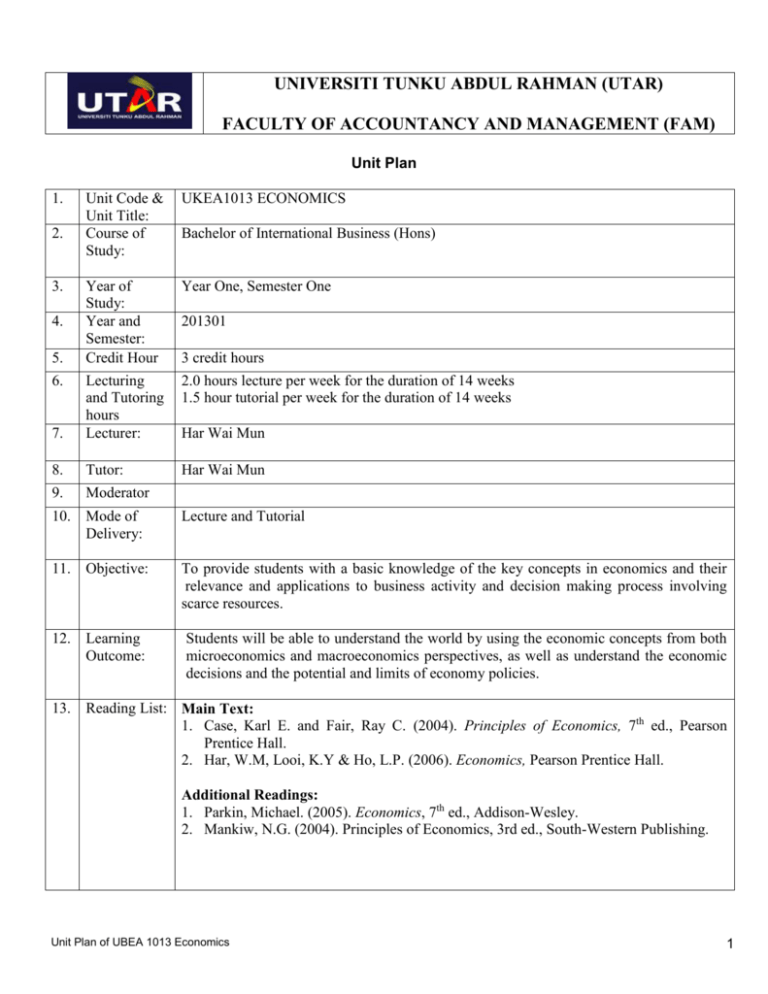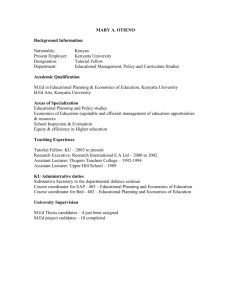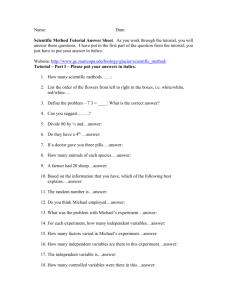
UNIVERSITI TUNKU ABDUL RAHMAN (UTAR)
FACULTY OF ACCOUNTANCY AND MANAGEMENT (FAM)
Unit Plan
1.
Unit Code &
Unit Title:
Course of
Study:
UKEA1013 ECONOMICS
Year One, Semester One
7.
Year of
Study:
Year and
Semester:
Credit Hour
Lecturing
and Tutoring
hours
Lecturer:
8.
Tutor:
Har Wai Mun
9.
Moderator
10.
Mode of
Delivery:
Lecture and Tutorial
11.
Objective:
To provide students with a basic knowledge of the key concepts in economics and their
relevance and applications to business activity and decision making process involving
scarce resources.
12.
Learning
Outcome:
Students will be able to understand the world by using the economic concepts from both
microeconomics and macroeconomics perspectives, as well as understand the economic
decisions and the potential and limits of economy policies.
13.
Reading List: Main Text:
1. Case, Karl E. and Fair, Ray C. (2004). Principles of Economics, 7th ed., Pearson
Prentice Hall.
2. Har, W.M, Looi, K.Y & Ho, L.P. (2006). Economics, Pearson Prentice Hall.
2.
3.
4.
5.
6.
Bachelor of International Business (Hons)
201301
3 credit hours
2.0 hours lecture per week for the duration of 14 weeks
1.5 hour tutorial per week for the duration of 14 weeks
Har Wai Mun
Additional Readings:
1. Parkin, Michael. (2005). Economics, 7th ed., Addison-Wesley.
2. Mankiw, N.G. (2004). Principles of Economics, 3rd ed., South-Western Publishing.
Unit Plan of UBEA 1013 Economics
1
14.
Method of
Assessment:
No. Method of Assessment
1.
Coursework
a) Mid-term Test I
b) Mid-term Test II
Total
2.
Final Examination
GRAND TOTAL
Total
40%
20%
20%
40%
60%
100%
1. Coursework (40%)
a) Midterm Test I: 20%
Tests will be given to monitor student’s progress on the understanding of the lectures.
The duration of the test will be 1 hours. Mid Term test I will be scheduled at WEEK 5.
The test will consist of one section and require students to answer all questions. Topic to
be covered are
b) Midterm Test II: 20%
Tests will be given to monitor student’s progress on the understanding of the lectures.
The duration of the test will be 1 hours. Mid Term test I will be scheduled at WEEK 8.
The test will consist of one section and require students to answer all questions.
2. Final Examination (60%)
The final examination for this subject will be 2 hours and will consist of TWO sections:
Section A (40 marks) = One compulsory essay question
Section B (60 marks) = Three essay questions (students need to answer any two
questions)
All students should achieve a minimum 40 marks for final examination to pass this paper.
Otherwise, students will have to sit for the supplementary exam.
15.
Remark:
ACADEMIC REGULATIONS
Plagiarism
Plagiarism is defined as the submission or presentation of work, in any form, which is not
one's own, without acknowledgment of the sources. If a student obtains information or
ideas from an outside source, that source must be acknowledged. Another rule to follow is
that any direct quotation must be placed in quotation marks and the source immediately
cited.
Plagiarism is also defined as copy of all or part of the work of another student(s) of
current or previous batch of this University or another higher learning institution. The
Unit Plan of UBEA 1013 Economics
2
University's degree and other academic awards are given in recognition of the candidate's
personal achievement. Plagiarism is therefore considered as an act of academic
fraudulence and as an offence against University discipline.
Intellectual Property
Copyright must be seriously protected. The University takes a strong stand against any
illegal photocopying of textbooks and any other materials by students. Students are
forewarned of the consequences and the penalty that may be meted out if they are "caught
in the act".
Mode of Referencing
Students are advised to incorporate proper academic modes of referencing. The normally
acceptable mode of academic referencing is the American Psychological Association
(APA) system; please refer to the attached APA referencing system document for detailed
usage.
Fieldwork Clause (where applicable)
Students are reminded of the importance to consider their personal safety when
conducting research in the field. You will be exposing yourself in new situations and
meeting with people who are unknown to you. It is important that you are aware of
potential dangers and take the necessary safety steps. You have to be extra careful and
cautious if you are going to interview or conduct survey with small, unknown
organizations or individuals 'on site'.
You should ensure you have the full details (full name, job title, organization name,
address and telephone numbers) of anyone or organization you intend to conduct the field
research. You should establish the credibility of these respondents before your groups
visit them. The field research should be made in groups not alone. Leave word with your
fellow classmates on your field visit (details of place, contact numbers, person you are
interviewing or conducting survey with, expected time of return, etc). The field work
should be at office hours.
Teaching Plan
Week
1
(14 Jan 2013
–
19 Jan 2013)
2
(21 Jan 2013
–
26 Jan 2013)
Topics
Principles of Economics
Introduction
Scope of Economics
Economic Method
Economic Problems
Economics System
Demand, Supply and Market Equilibrium
Market Mechanism Principles
Demand
Supply
Market Equilibrium
Unit Plan of UBEA 1013 Economics
Tutorial Topic /
Assignment
Tutorial (Topic 1)
5 short questions
Tutorial (Topic 1)
6 short questions &
1 essay
References
CF Ch 1, 2
LH Ch 1
PM Ch 1, 2
CF Ch 3
LH Ch 2
PM Ch 3
3
3
(28 Jan 2013
–
2 Feb 2013)
4
(4 Feb 2013
–
9 Feb 2013)
5
(11 Feb 2013
–
16 Feb 2013)
6
(18 Feb 2006
–
23 Feb 2006)
7
(25 Mac 2013
–
2 Mac 2013)
Market efficiency and Elasticity
The Market System and Price Rationing
Market Failure
Constraint on the Market: Government
Intervention
Market Efficiency & Surpluses Maximization
Elasticity
Elasticity of supply
The Production Process of Firm
Production and Firm
Costs and Profit: Economics and Accounting
Concepts
The Production Decisions
The Production Process
Short Run Cost Curves and Relationship
Long-Run Cost Curve
Short-Run Revenue and Profit Maximization
Tutorial (Topic 2)
4 short questions &
2 essays
Tutorial (Topic 3)
4 short questions &
2 essays
Market Structure: Perfect Competition
Characteristics of Perfect Competition Market
Short-run Decision: Profit Maximization
Short-run Decision: Minimizing Losses
Long-run Adjustment
External Changes: Consumer Preference and
Technology
Efficiency of Perfect Competition
Tutorial (Topic 4)
Market Structure: Monopoly
Characteristics of Monopoly Market
Short-run Decision: Profit Maximization
Short-run Decision: Minimizing Losses
Long-run Profit Maximization and Misconception
Social Costs of Monopoly
Natural Monopoly
Tutorial (Topic 5)
Market Structure: Monopolistic Competition
Characteristics of Monopolistic Competition
Market
Product Differentiation and Advertising
Demand Curve and Marginal Revenue Curve
Price and Output Determination in the Short-run
Long-run Decision
Efficiency of Monopolistic Competition versus
Perfect Competition
2 essays
CF Ch 4
LH Ch 3
PM Ch 4
CF Ch 6, 7,
8
LH Ch 4
PM Ch 10
CF Ch 7, 8,
11
LH Ch 5
PM Ch 11
Mid Term Test I
on Week 5
Revision questions
(10 true/false)
& 3 essays
Tutorial (Topic 6)
3 short questions &
2 essays
CF Ch 12
LH Ch 6
PM Ch 12
CF Ch 13
LH Ch 7, 8
PM Ch 13
Market Structure: Oligopoly
Characteristics of Oligopoly Market
Contestable Market
Oligopoly Models
Unit Plan of UBEA 1013 Economics
4
8
(4 Mac 2013
–
9 Mac 2013)
9
(11 Mac 2013
–
16 Mac 2013)
10
(18 Mac 2013
–
23 Mac 2013)
11
(25 Mac 2013
–
30 Mac 2013)
12
(1April 2013
–
6 April 2013)
13
(8 April 2013
–
13 April 2013)
Oligopoly Behavior and Strategy in Game Theory
Efficiency of Oligopoly
Introduction to Macroeconomics
The Root and History of Macroeconomics
Concern of Macroeconomics
Government Policy
The Component of Macro-economy
Economics School of Thought
Measuring National Output ad National Income
Gross Domestic Product
The Expenditure Approach
The Income Approach
The Industrial Origin Approach
GNP and Personal Income
Nominal and Real GDP
Limitations of the GDP Concept
Tutorial (Topic 7)
4 short questions &
2 essays
Mid Term Test II
on Week 8
Tutorial (Topic 8)
2 short questions &
2 essays
Aggregate Expenditure and Equilibrium Output
Components of Aggregate Expenditure Model
Aggregate Income
Consumption and Saving
Planned Investment
Government Expenditure and Taxation
Equilibrium Aggregate Output (Income)
The Multiplier Effect
Tutorial (Topic 9)
Fiscal and Monetary Policy
The Fiscal Policy
Money Supply & Central bank System
The Monetary Policy
Multiplier Effect
Crowding-Out Effect
The Macroeconomic Policy Mix: Fiscal and
Monetary Policy
Tutorial (Topic 10)
Aggregate Demand-Supply Model
The Aggregate Demand Curve
The Short-Run Aggregate Supply Curve
The Long-Run Aggregate Supply Curve
Aggregate Demand and Supply: Equilibrium and
Changes
Tutorial (Topic 11)
International Trade & Exchange Rate
Absolute Advantage and Comparative Advantage
Theory
Restriction to Free Trade
Open Economy: Export and Import
Exchange Rate
Tutorial (Topic 12)
Unit Plan of UBEA 1013 Economics
CF Ch 17,
19
LH Ch 9
PM 20, 22,
23, 25
4 structure
questions
2 essays
5 essays
2 short questions &
2 essays
CF Ch 18
LH Ch 10
PM 21
CF Ch 20
LH Ch 11
PM Ch 29
CF Ch 21,
23
LH Ch 13
PM Ch 31,
32
CF Ch 24,
25
LH Ch 14
PM Ch 23
CF Ch 32,
33
LH Ch 15
PM Ch 33,
34
5
14
Tutorial (Topic 13)
Revision
(15 April 2013
–
20 April 2013)
1 essay & revision
CF = Case, Karl E. and Fair, Ray C (2004); LH = Har, W.M, Looi, K.Y & Ho, L.P (2006); PM = Parkin,
Michael (2005)
This Unit Plan is:
Prepared by:
Moderated by:
Approved by:
____________________
(Name: Har Wai Mun)
Lead Lecturer
____________________
(Name:
)
Moderator
______________________
(Name: Chong Shyue Chuan )
Head of Department
Date: 15 Jan 2013
Date:
Date:
Notes: The information provided in this Unit Plan is subject to change by the Lecturers. Students shall be notified in advance
of any changes.
Unit Plan of UBEA 1013 Economics
6





